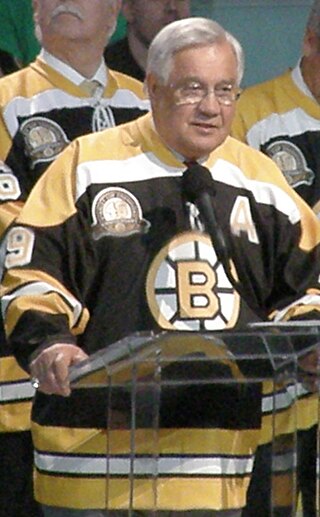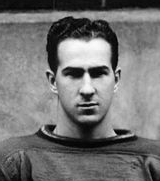
The Boston Bruins are a professional ice hockey team based in Boston. The Bruins compete in the National Hockey League (NHL) as a member of the Atlantic Division in the Eastern Conference. The team has been in existence since 1924, making them the third-oldest active team in the NHL, and the oldest in the United States.

Arthur Howey Ross was a Canadian professional ice hockey player and executive from 1905 until 1954. Regarded as one of the best defenders of his era by his peers, he was one of the first to skate with the puck up the ice rather than pass it to a forward. He was on Stanley Cup championship teams twice in a playing career that lasted thirteen seasons; in January 1907 with the Kenora Thistles and 1908 with the Montreal Wanderers. Like other players of the time, Ross played for several different teams and leagues, and is noted for his time with the Wanderers while they were members of the National Hockey Association (NHA) and its successor, the National Hockey League (NHL). In 1911, he led one of the first organized player strikes over increased pay. When the Wanderers' home arena burned down in January 1918, the team ceased operations and Ross retired as a player.

John Paul "Chief" Bucyk is a Canadian former professional ice hockey left winger and member of the Hockey Hall of Fame. Having played most of his career with the Boston Bruins, he has been associated in one capacity or another with the Bruins' organization since the late 1950s. Bucyk was named one of the '100 Greatest NHL Players' in 2017.

Robert Theodore Bauer was a Canadian professional ice hockey right winger who played 10 seasons in the National Hockey League (NHL) for the Boston Bruins. He was a member of the famed "Kraut Line" with teammates Milt Schmidt and Woody Dumart. The trio led the Bruins to two Stanley Cup championships and became the first line to finish first, second and third in NHL scoring, in 1939–40. Bauer was named to the All-Star team four times and was a three-time winner of the Lady Byng Trophy, awarded for gentlemanly conduct combined with a high calibre of play. He recorded only 36 penalties in minutes in 327 games.

William Mailes "Cowboy" Cowley was a Canadian professional ice hockey centre who played 13 seasons in the National Hockey League for the St. Louis Eagles and Boston Bruins. Described as the Wayne Gretzky of his era, Cowley twice won the Hart Memorial Trophy as the NHL's MVP, and is widely regarded as one of the best playmakers in hockey history.

Woodrow Wilson Clarence Dumart was a Canadian professional ice hockey player, most notably for the Boston Bruins of the National Hockey League. He is an Honoured Member of the Hockey Hall of Fame. Dumart's uncle Ezra Dumart was also a professional ice hockey player.

Milton Conrad Schmidt was a Canadian professional ice hockey centre, coach and general manager, mostly for the Boston Bruins of the National Hockey League (NHL), where he was a member of the Kraut Line. He was elected to the Hockey Hall of Fame in 1961. In 2017, Schmidt was named one of the '100 Greatest NHL Players' in history.
The 1939–40 NHL season was the 23rd season for the National Hockey League. Of the league's seven teams, the Boston Bruins were the best in the 48-game regular season, but the Stanley Cup winners were the New York Rangers, who defeated the Toronto Maple Leafs in the best-of-seven final series 4–2 for their third Stanley Cup in 14 seasons of existence. It would be another 54 years before their fourth.
The 1944–45 NHL season was the 28th season of the National Hockey League. Six teams each played 50 games. The Toronto Maple Leafs won the Stanley Cup in seven games versus the Detroit Red Wings.
The 1960–61 NHL season was the 44th season of the National Hockey League. The Chicago Black Hawks defeated the Detroit Red Wings in the Stanley Cup Finals four games to two to win the Stanley Cup. It was the first series since 1950 with two American-based teams. It was Chicago's first Cup win since 1938; they would not win another until 2010.
The 1954–55 NHL season was the 38th season of the National Hockey League. The Detroit Red Wings were the Stanley Cup champions as they defeated the Montreal Canadiens four games to three in the best-of-seven final series. The Canadiens were without star forward Maurice 'Rocket' Richard who had been suspended for the playoffs, a suspension which led to the March 17, 1955 "Richard Riot" in Montreal.
The 1936–37 NHL season was the 20th season of the National Hockey League (NHL). Eight teams each played 48 games. The Detroit Red Wings were the Stanley Cup winners as they beat the New York Rangers three games to two in the final series.

Herbert James Cain was a Canadian professional ice hockey left winger who played 13 seasons in the National Hockey League (NHL) for the Montreal Maroons, Montreal Canadiens, and Boston Bruins between 1933 and 1946.
The Kitchener Greenshirts name has been used by five separate ice hockey teams playing in Kitchener, Ontario, Canada. These include one 'Senior A' level hockey team, two 'Junior A' level teams, and two 'Junior B' level teams. The name has also been used for a team in the Ontario Minor Hockey Association (OMHA).
Donald Calvin Gallinger was a Canadian ice hockey player who played 222 games in the National Hockey League with the Boston Bruins between 1942 and 1948. Born in Port Colborne, Gallinger was one of the league's youngest players when he broke into the NHL, playing on the "Sprout Line" of Boston with Bill Shill and Bep Guidolin. Gallinger's career was cut short when in 1948 Gallinger and former team-mate Billy Taylor were discovered gambling on their teams and banned for life by the NHL. They were reinstated in 1970 and these are the longest suspensions in NHL history. Before the suspension, Gallinger had established himself as an effective offensive NHL player and, as an excellent multi-sport athlete, had even been sought after to play professional baseball.
The 1939 Stanley Cup Finals was contested by the Boston Bruins and the Toronto Maple Leafs. It was Boston's first appearance in the Finals since 1930; Toronto had appeared in the previous year. Boston won the series 4–1 to win their second Stanley Cup. This was the first Stanley Cup Finals to be contested as a best-of-seven series, and every subsequent Stanley Cup Finals have been contested as such.
The 1940–41 Boston Bruins season was the Bruins' 17th season in the National Hockey League, and they were coming off of a successful season in 1939–40, leading the NHL in points for the third season in a row, as they finished with a 31–12–5 record, accumulating 67 points. However, the Bruins lost to the New York Rangers in the NHL semifinals, ending their chances for a second-straight Stanley Cup. This year, the Bruins repeated as regular season champions and returned to the Stanley Cup Finals, defeating the Detroit Red Wings four games to none to win the organization's third Stanley Cup.
The 1941–42 Boston Bruins season, was the team's 18th season. They placed third in the National Hockey League.
The 1945–46 Boston Bruins season was the Boston Bruins 22nd season of operation in the National Hockey League. The Bruins made it to the 1946 Stanley Cup Finals only to lose to the rival Montreal Canadiens four games to one.
The 1951–52 Boston Bruins season was the Bruins' 28th season in the NHL.








